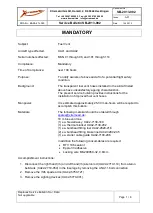
SECTION VI CHEROKEE "E"
air to escape from the strut housing chamber. Remove the filler
plug and slowly raise the strut to full compression. If the strut
has sufficient fluid it will be visible up to the bottom of the
filler plug hole and will then only require proper inflation.
Should fluid be below the bottom of the filler plug hole, oil
should be added. Replace the plug with valve core removed, attach
a clear plastic hose to the valve strut of the filler plug and sub-
merge the other end in a container of hydraulic fluid (MIL-H-5606).
Fully compress and extend the strut several times thus drawing
fluid from the container and expelling air from the strut chamber.
To allow the fluid to enter the bottom chamber of the main gear
strut housing, the torque link assembly must be disconnected to
let the strut be extended a minimum of 10 inches. (The nose gear
torque links need not be disconnected.) Do not allow the strut to
extend more than 12 inches. When air bubbles cease to flow
through the hose, compress the strut fully and again check fluid
level. Reinstall the valve core and filler plug, and the main gear
torque links, if disconnected.
With fluid in the strut housing at the correct level, attach a
strut pump to the air valve and with the airplane on the ground,
inflate the oleo strut to the correct height.
In jacking the Cherokee for landing gear or other service, a
jack kit (available through Piper Dealers or Distributors) should
be used. This kit consists of two hydraulic jacks and a tail stand.
At least 250 pounds of ballast should be placed on the base of
the tail stand before the airplane is jacked up. The hydraulic
jacks should be placed under the jack points on the bottom of
the wing and the airplane jacked up until the tail skid is at the
right height to attach the tail stand. After attaching the tail
stand and adding the ballast, the jacking may be continued until
the aircraft is at the height desired.
The steering arms from the rudder pedals to the nose wheel
are adjusted at the rudder pedals or at the nose wheel by turning
in or out the threaded rod end bearings. Adjustment is normally
accomplished at the forward end of the rods and should be done
in such a way that the nose wheel is in line with the fore and aft
axis of the plane when the rudder pedals and rudder are centered.
44 753 806
740118
Summary of Contents for CHEROKEE 180 E
Page 1: ...CHEROKEE 180 E OWNER S HANDBOOK...
Page 5: ......
Page 6: ......
Page 10: ......
Page 12: ......
Page 16: ...SECTION I CHEROKEE E 691015 4...
Page 18: ......
Page 25: ...CHEROKEE E SECTION II 691015 11 ELECTRICAL SYSTEM...
Page 28: ...691212 14...
Page 29: ...CHEROKEE E SECTION II NOTES 691015 15...
Page 30: ......
Page 32: ......
Page 44: ......
Page 46: ......
Page 56: ......
Page 58: ......
Page 66: ......
Page 68: ......
Page 76: ...SECTION VI CHEROKEE E NOTES 50 753 806 740118...
Page 77: ...CHEROKEE E SECTION VI 753 8O6 740118 51 52...
Page 78: ......









































